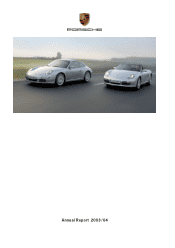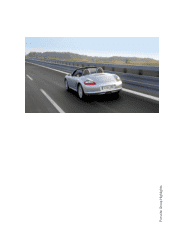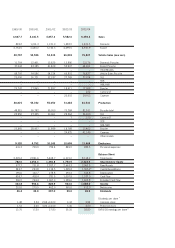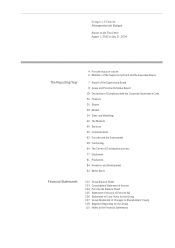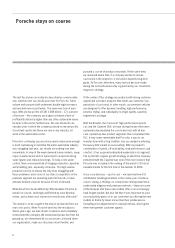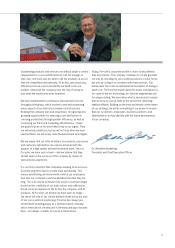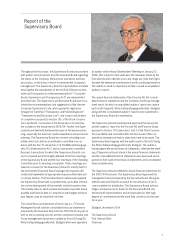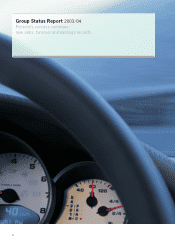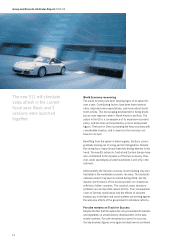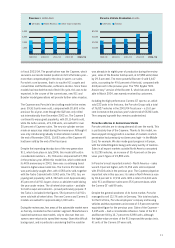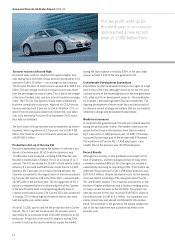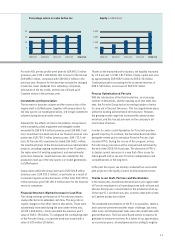Porsche 2003 Annual Report Download - page 8
Download and view the complete annual report
Please find page 8 of the 2003 Porsche annual report below. You can navigate through the pages in the report by either clicking on the pages listed below, or by using the keyword search tool below to find specific information within the annual report.
4
Porsche stays on course
The last fiscal year can safely be described as a memorable
one, and the most successful year ever for Porsche. Sales
volume and turnover both underwent double-digit increases
and reached new record levels. The same was true of earn-
ings. With pre-tax profits of EUR 1.088 billion – 17.1 percent
of turnover – the company once again achieved a level of
profitability distinctly higher than any other automobile manu-
facturer in the world. Furthermore, this was the tenth con-
secutive year in which the company posted increased profits.
Consistent results like these are rare in any industry, let
alone in the automobile sector.
Porsche’s continuing success story seems impressive enough
in itself, but bearing in mind that the entire automobile industry
was struggling last year, our results are nothing less than
remarkable. In view of the weak demand in key markets, many
major manufacturers had no option but to accept shrinking
sales figures and reduced earnings. To keep costs under
control, there is increased talk of merging production capacities
and shedding jobs, especially in Europe. The high-volume
producers are by no means the only ones struggling with
these problems: even some of our direct competitors in the
premium segment are operating well into the red, or have
announced plant closures because of lack of demand.
What does Porsche do differently? What enables Porsche to
remain on course, seemingly unaffected by such develop-
ments, and achieve such impressive results year after year?
The answer is to be sought in the lesson we learned from our
own crisis years. When Porsche went into the red about a
dozen years ago, we took drastic measures and completely
restructured the company. We modernized production from the
ground up, we streamlined all our processes, slimmed down
our organization, made our structures more flexible, and
pursued a course of product innovation. At the same time,
we remained aware that, if a company wishes to remain
successful in the long term, it must work towards long-term
goals. At Porsche, therefore, every tactical decision made
during the normal business day is governed by our consistent,
long-term strategy.
At the center of this strategy are products with strong customer
appeal and a product program that meets our customer’s ex-
pectations of our brand. In other words, our premium vehicles
are designed to offer dynamic handling, high performance,
emotive styling, and individuality in a high-quality, superbly
engineered package.
With the Boxster, the Carrera GT high performance sports
car, and the Cayenne SUV, we have during the past few years
systematically expanded the core brand and, with all due
care, opened up new product segments that complement the
911. It may seem remarkable that Porsche, a sports car
manufacturer with a long tradition, has succeeded in entering
the luxury SUV market so successfully. With its product’s
combination of speed, off-road ability, road performance, and
comfort, it has acquired undisputed leadership in its segment.
The systematic organic growth strategy on which the company
embarked with the Cayenne was one of the main reasons that
Porsche was included in the ranking of the world’s 100 most
valuable brands for the first time in the summer of 2004.
In our core business – sports cars – we launched new 911
and Boxster model generations in the review year. Timeless,
classic styling, a thrilling, no-compromise driving experience,
understated elegance and premium materials – these are some
of the features that these new models offer in an increasingly
hard-fought market. We also felt that it was important to pass
our productivity gains on to our customers by offering the new
models at distinctly lower prices than their predecessors
(including price adjustments for optional extras), which gives
them even greater customer appeal.

